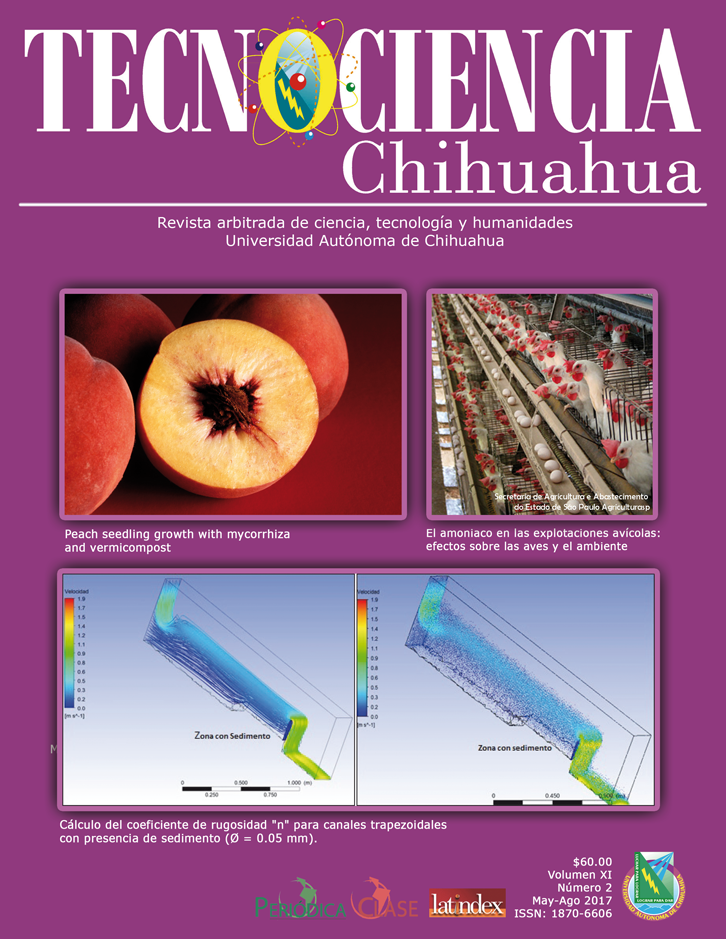Técnica de evaluación para damping-off en frijol (Phaseolus vulgaris l.) infectado por Pythium aphanidermatum
Screening technique for damping-off in bean (Phaseolus vulgaris l.) infected by Pythium aphanidermatum
Resumen
Se realizó un experimento de laboratorio con seis variedades de frijol que representan un rango de capacidad germinativa y colores de testa de semilla; fueron sembrados e infectados con inóculo del patógeno Pythium aphanidermatum (Edson) Fitzp. El objetivo fue desarrollar técnica de evaluación para pudrición de semilla y damping-off, producidas por Pythium aphanidermatum en cultivares de frijol común (Phaseolus vulgaris L.). Se utilizó un diseño completamente aleatorizado con arreglo factorial 6 x 2 y tres repeticiones; el Factor A, consistió de seis cultivares: Mantequilla Tropical, Azufrado, Negro Jamapa, Delicias 71, Agramejo y Selección # 4; el Factor B, representado por dos concentraciones del patógeno, niveles 0 y 104 esporas.ml-1; la unidad experimental (UE) estuvo representada por 20 semillas de frijol, sembradas en una caja de Petri. Los resultados indican que la inoculación y la técnica de evaluación, fueron exitosas para causar enfermedades por Pythium y discriminar un grado variable de resistencia al patógeno que estuvo claramente asociado con el tipo de cultivar. Las variedades Negro Jamapa, cuya testa color negro y Azufrado con tegumentos amarillos, fueron más resistentes al patógeno, mientras que los cultivares Delicias 71 y Selección # 4, ambos con testas manchadas o pinto, mostraron mayor susceptibilidad a Pythium. Los daños y síntomas observados en cultivares susceptibles fueron: baja germinación, alto porcentaje de pudrición de semilla y raíz, además, se observó presencia de micelio.
Citas
Adegbola, M.O.K. & D.J. Hagedorn. 1970. Host resistance and Pathogen Virulence in Pythium Blight of Bean. Phytopathology 60: 1477-1479. https://tinyurl.com/mr2de7v7
Bates, G.D., C.S. Rothroch & J.C. Rupe. 2008. Resistance of the Soybean Cultivar Archer to Pythium Damping-Off and Root Rot Caused by Several Pythium spp. Plant Disease 92 (5): 763-766. https://doi.org/10.1094/PDIS-92-5-0763
Binagwa, P.H., K. K. Bonsi & S.N. Msolla. 2016. Evaluation of Common Bean (Phaseolus vulgaris) Genotypes for Resistance to Root Rot Disease Caused by Pythium aphanidermatum and Pythium splendens under Screen House Conditions. Journal of Natural Sciences Research 6 (6): 36-43. https://tinyurl.com/3r6zvxcw
Hall, R. 1991. Compendium of Bean Diseases. APS Press. ISBN 0890541183
Harman, G.E. 1983. Mechanisms of Seed Infection and Pathogenesis. Phytopathology. 73 (2): 326-329. https://tinyurl.com/4uutmtj9
Hendrix, F.F. & A. Campbell. 1973. Phytium as Plant Pathogens. Ann. Rev. Phytopathol. 11: 77-98. https://doi.org/10.1146/annurev.py.11.090173.000453
Ingram, D.M. & R.J. Cook. 1990. Pathogenecity of Four Pythium Species to Wheat, Barley, Peas, and Lentils. Plant Pathology. 39(1):110-117. https://doi.org/10.1111/j.1365-3059.1990.tb02481.x
Lookabaugh, E.C., K.L. Ivors & B.B. Shew. 2015. Mefenoxam sensivity, aggressiveness, and identification of Pythium species causing root rot on floriculture crops in North Carolina. Plant Disease 99 (11): 1551-1558. https://doi.org/10.1094/PDIS-02-15-0232-RE
Lucas, B. & P.D. Griffiths. 2004. Evaluation of common bean accessions for resistance to Phytium ultimum. HortScience. 39 (6): 1193-1195. https://doi.org/10.21273/HORTSCI.39.6.1193
Mitchell, D.J. & P.A. Rayside. 1986. Isolating, Identifying, and Producing Inoculum of Phytium spp. En Methods for Evaluating Pesticides for Control of Plant Pathogens. (p.312). APS. Press.
Nelson, E.B. 1987. Rapid Germination of Sporangia of Pythium Species in Response to Volatiles from Germinating Seeds. Phytopathology 77 (7): 1108-1112. https://tinyurl.com/4dwat747
Nzungize, J.R., F. Lyumugabe, J.P. Busogoro & J.P. Baudoin. 2012. Phytium root rot of common bean: biology and control methods. A review. Biotechnol. Agron. Soc. Environ. 16 (3): 405-413. https://popups.uliege.be/1780-4507/index.php?id=9019
Pieczarka, D.J. & G.S. Abawl. 1978. Populations and Biology of Pythium Species Associated with Snap Bean Roots and Soils in New York. Phytopathology 68: 409-416. https://tinyurl.com/mpdsvdzf
Royle, D.J. & C.J. Hickman. 1964. Analysis of Factors Governing In Vitro Accumulation of Zoospores of Pythium aphanidermatum on Roots. I. Behavior of Zoospores. Can. J. Microbiology. 10: 151-162.
Scheurell, S.J., D.M. Sullivan & W.F. Mahaffee. 2005. Suppression of Seedling Damping-Off Caused by Pythium ultimum, P. irregulare, and Rhizoctonia solani in Container Media Amended with a Diverse Range of Pacific Northwest Compost Sources. Phytopathology 95 (3) : 306-315. https://doi.org/10.1094/phyto-95-0306
Stanghellini, M.E. & Burr, T.J. 1975. Effect of Soil Water Potential on Disease Incidence and Oospore Germination of Pythium aphanidermatum. Phytopathology 63: 1496-1498. https://tinyurl.com/3msdf6sc
Stasz, T.E., G.E. Harman & G.A. Marx. 1980. Time and Site of Infection of Resistant and Susceptible Germinating Pea Seeds by Pythium ultimum. Phytopathology 70(8): 730-733. https://tinyurl.com/4n74fmkm
Urrea, K., J. Rupe, P. Chen & C.S. Rothrock. 2017. Characterization of Seed Rot Resistance to Pythium aphanidermatum in Soybean. Crop Science. 57(3):1394-1403. https://doi.org/10.2135/cropsci2016.08.0669
Valdes, O. A., R. García, O. Sánchez & A. Pérez. 2011. Aislamiento y patogenicidad de un posible Pythium aphanidermatum en Jaropha curcas L. no tóxica. Tropical and Subtropical Agroecosystems. 14(2): 649-660. https://www.scielo.org.mx/scielo.php?script=sci_arttext&pid=S1870-04622011000200022
Watanabe, T. & M. Yoshida. 1983. Quantitative Assay of Sporangia and Zoospore Production by Pythium aphanidermatum with a Soaking Plain Water Agar Culture Method. Ann. Phytopathol. Soc. Japan. 49(2): 137-142. https://doi.org/10.3186/jjphytopath.49.137
Derechos de autor 2017 TECNOCIENCIA Chihuahua

Esta obra está bajo licencia internacional Creative Commons Reconocimiento-NoComercial 4.0.







